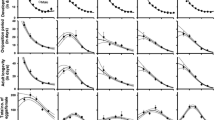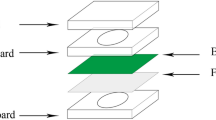Abstract
The intrinsic rate of natural increase(rm) is useful to estimate the populationgrowth potential of insects and mites, whichmay help predict the outcome of pest-naturalenemy interactions. This study was conductedto determine how 12 constant temperatureregimes between 10–38 °C (± 0.5 °C) may differentially affect therm of the McDaniel spider mite, Tetranychus mcdanieli McGregor (Acarina: Tetranychidea), a common pest of raspberry, andits coccinellid predator, Stethoruspunctillum Weise (Coleoptera: Coccinellidae). Tetranychus mcdanieli survived tomaturity in the 14–36 °C range, comparedto the 14–32 °C range for S.punctillum. Survival above 24 °Cremained high for the spider mite, butdecreased markedly for the coccinellid. Tetranychus mcdanieli's range forreproduction was similar to its survival range,but S. punctillum failed to reproduce at14 °C and reproduced only poorlyat 16 °C. Offspring production peakedat 24 °C for both T. mcdanieli(average 152 eggs per female), and S.punctillum (280 eggs per female). At alltemperatures suitable for reproduction, femalelongevity of the coccinellid was greater thanthe spider mite, which was characterized byearlier/faster reproduction than thecoccinellid. As temperature increased, therm followed a typical asymmetricaldome-shape pattern, with maximum values of0.196 d−1 and 0.385 d−1at 30 °C and 34 °C, for S.punctillum and T. mcdanieli,respectively. For each species, therm-temperature relation was successfullymodelled using a curvilinear regressionequation previously shown to predictdevelopment rate. In both species, thedevelopment rate response to temperature has amajor influence on the temperature-rmrelationship. In the 16–32 °C rangesuitable for population growth of both species,the rm of T. mcdanieliwas 1.9 (30 °C) to 8 (16 °C) times greaterthan S. punctillum. These growthpotential ratios are consistently in favor ofthe prey, suggesting a limitation of thecoccinellid with respect to its capacity totrack T. mcdanieli populations. However,under short season conditions, the inferiorreproductive dynamics of S. punctillum'svs. spider mite prey should not have aprevailing influence in determining impact, andmay be compensated by high voracity incombination with a strong aggregativeresponse.
Similar content being viewed by others
References
Andrewartha, H.G. and L.C. Birch, 1954. The distribution and abundance of animals. University of Chicago Press, Chicago.
Birch, L.C., 1948. The intrinsic rate of natural increase of an insect population. J. Anim. Ecol. 17: 1–26.
Biswas, S. and R. Singh, 1997. Interrelationship between host density, temperature, offspring, sex ratio and intrinsic rate of natural increase of the aphid parasitoid Lysiphlebia mirzai reared on resistant and susceptible food plant cultivars (Hymenoptera: Braconidae: Aphidiinae). Entomol. Gen. 22: 23–249.
Bonato, O., 1999. The effect of temperature on life history parameters of Tetranychus evansi (Acari: Tetranychidae). Exp. Appl. Acarol. 23: 1–19.
Breton, G., 1991. État de la situation sur la culture de la framboise au Québec. Colloque sur la framboise. Point sur la culture. CPVQ. pp. –14.
Brière, J.F., P. Pracos, A.Y. Le Roux and J.S. Pierre, 1999. A novel rate model of temperaturedependent development for arthropods. Environ. Entomol. 28: 2–29.
Chazeau, J., 1974. Développement et fécondité de Stethorus madecassus (Coléoptères, Coccinellidae), élevé en conditions extérieures dans le sud-ouest de Madagascar. Cah. ORSTOM, ser. Biol. 25: 2–33.
Chazeau, J., 1985. Predaceous insects. In: W. Helle and M.W. Sabelis (eds), Spider mites. Their biology, natural enemies and control, 1B. Elsevier, Amsterdam. pp. 21–246.
Chazeau, J., E. Bouyé and L. Bonnet de Laborgne, 1991. Cycle de développement et table de vie d'Olla V-nigrum (Col.: Coccinellidae) ennemi naturel d'Heteropsylla cubana (Hom.: Psyllidae) introduit en Nouvelle-Calédonie. Entomophaga 36: 27–285.
Cloutier, C., D. Arodokoun, S.G. Johnson and L. Gélinas, 1995. Thermal dependence of Amblyseius cucumeris (Acarina: Phytoseiidae) and Orius insidiosus (Heteroptera: Anthocoridae) in greenhouses. In: B.L. Parker, M. Skinner and T. Lewis (eds.), Thrips biology and management. Plenum Press, New York. pp. 23–235.
Dent, D.R., 1997. Quantifying insect populations: estimates and parameters. In: D.R. Dent and M.P. Walton (eds), Methods in ecological and agricultural entomology. CAB International, Oxford. pp. 5–98.
Dixon, A.F.G., 2000. Insect predator-prey dynamics: ladybird beetles and biological control. Cambridge University Press, Cambridge.
Fabres, G. and A. Kiyindou, 1985. Comparaison du potentiel biotique de deux coccinelles (Exochomus flaviventris et Hyperaspis senegalensis hottentotta, Col. Coccinellidae) prédatrices de Phenacoccus manihoti (Hom. Pseudococcidae) au Congo. Acta Oecol. 6: 33–348.
Janssen, A. and M.W. Sabelis, 1992. Phytoseiid life-histories, local predator-prey dynamics, and strategies for control of tetranychid mites. Exp. Appl. Acarol. 14: 23–250.
Jervis, M.A. and M.J.W. Copland, 1996. The life cycle. In: M. Jervis and B. Kidd (eds), Insect natural enemies; Practical approaches to their study and evaluation. Chapman and Hall, London. pp. 6–161.
Kairo, M.T.K. and S.T. Murphy, 1995. The life history of Rodalia iceryae Janson (Col., Coccinellidae) and the potential for use in innoculative releases against Icerya pattersoni Newstead (Hom., Margarodidae). J. Appl. Entomol. 119: 48–491.
Kanika-Kiamfu, J., A. Kiyindou, J. Brun and G. Iperti, 1992. Comparaison des potentialités biologiques de trois coccinelles prédatrices de la cochenille farineuse du manioc Phenacoccus manihoti (Hom. Pseudococcidae). Entomophaga 37: 27–282.
Lactin, D.J., N.J. Holliday, D.L. Johnson and R. Craigen, 1995. Improved rate model of temperature-dependent development by arthropods. Environ. Entomol. 24: 6–75.
Lamb, R.J., 1992. Developmental rate of Acyrthosiphon pisum (Homoptera: Aphididae) at low temperatures: implications for estimating rate parameters for insects. Environ. Entomol. 21: 1–19.
Logan, J.A., D.J. Wollkind, S.C. Hoyt and L.K. Tanigoshi, 1976. An analytical model for description of temperature dependent rate phenomena in arthropods. Environ. Entomol. 5: 113–1140.
Lopez-Arroyo, J.I., C.A. Tauber and M.J. Tauber, 1999. Comparative life histories of the predators Ceraeochrysa cincta, C-cubana, and C-smithi (Neuroptera: Chrysopidae). Ann. Entomol. Soc. Am. 92: 20–217.
McMurtry, J.A., C.B. Huffaker and M. van de Vrie, 1970. Tetranychid enemies: Their biological characters and the impact of spray practices. Hilgardia 40: 33–390.
McMurtry, J.A., G.T. Scriven and R.S. Malone, 1974. Factors affecting oviposition of Stethorus picipes (Coleoptera: Coccinellidae) with special reference to photoperiod. Environ. Entomol. 3: 12–127.
Obrycki, J.J., D.B. Orr., R. Wallendorf and R.V. Flanders, 1993. Comparative developmental and reproductive biology of three populations of Propylea quatuordecimpunctata (Coleoptera: Coccinellidae). Biol. Control 3: 2–33.
Phoofolo, M.W. and J.J. Obrycki, 1995. Comparative life-history studies of nearctic and paleacrtic populations of Coccinella septempunctata (Coleoptera: Coccinellidae). Environ. Entomol. 24: 58–587.
Pradhan, S., 1946. Insect population studies. IV. Dynamics of temperature of temperature effect on insect development. Proc. Natl. Inst. Sci. India Part B Biol. Sci. 12: 38–404.
Putnam, W.L., 1955. Bionomics of Stethorus punctillum Weise (Coleoptera: Coccinellidae) in Ontario. Can. Entomol. 87: –33.
Richardson, N.L., 1977. The biology of Stethorus loxtoni Britton and Lee (Coleoptera: Coccinellidae) and its potential as a predator of Tetranychus urticae Koch (Acarina: Tetranychidae) in California. Ph.D. Thesis. University of California, Berkeley, California, 184 pp.
Ricklefs, R.E. and G.L. Miller, 2000. Ecology. 3rd ed. Freeman and Company, New York.
Rott, A.S. and D.J. Ponsonby, 2000. The effects of temperature, relative humidity and host plant on the behaviour of Stethorus punctillum Weise (Coleoptera: Coccinellidae) as a predator of the two-spotted spider mite, Tetranychus urticae Koch: (Acari: Tetranychidae). BioControl 45: 15–164.
Roy, M. 2002. Etude de la prédation de Stethorus punctillum et d'Amblyseius fallacis sur les tétranyques du framboisier. Ph.D. Thesis, Université Laval, Québec, Canada.
Roy, M., J. Brodeur and C. Cloutier, 1999. Seasonal abundance of spider mites and their predators on red raspberry in Quebec. Environ. Entomol. 28: 73–747.
Roy, M., J. Brodeur and C. Cloutier, 2002. Relationship between temperature and developmental rate of Stethorus punctillum (Coleoptera: Coccinellidae) and its prey Tetranychus mcdanieli (Acarina: Tetranychidae). Environ. Entomol. 31: 17–187.
Sabelis, M.W., 1992. Predatory athropods. In: M.J. Crawley (ed), Natural enemies. The population biology of predators, parasites and disease. Blackwell, Oxford. pp. 22–264.
Sabelis, M.W., 1985a. Reproductive strategies. In: W. Helle and M.W. Sabelis (eds), Spider mites, their biology, natural enemies and control. Elsevier, Amsterdam. pp. 23–278.
Sabelis, M.W., 1985b. Capacity for population increase. In: W. Helle and M.W. Sabelis (eds), Spider mites, their biology, natural enemies and control. Elsevier, Amsterdam. pp. 3–53.
Sabelis, M.W., 1991. Life-history evolution in spider mites. In: R. Schuster and P.W. Murphy (eds), The Acari: Reproduction, Development, and Life-History Strategies. Chapman and Hall, Amsterdam. pp. 2–49.
Shen, M., Z. Guo and J. Xiong, 1999. Influence of temperature on the experimental population of Stethorus punctillum. Acta Ecol. Sinica 18: 18–187.
Siddiqui, W.H., C.A. Barlow and P.A. Randolph, 1973. Effects of some constant and alternating temperatures on population growth of the pea aphid, Acyrthosiphon pisum (Homoptera: Aphididae). Can. Entomol. 105: 14–156.
Southwood, T.R.E. and P.A. Henderson, 2000. Ecological methods. Kluwer Academic Press, London.
Stäubli Dreyer, B., P. Neuenschwander, B. Bouyjou, J. Baumgärtner and S. Dorn, 1997. The influence of temperature on the life table of Hyperaspis notata. Entomol. Exp. Appl. 84: 8–92.
Tanigoshi, L.K., 1973. Studies of the dynamics of predation of Stethorus picipes Coleoptera: Coccinellidae) and Typhlodromus floridanus on the prey Olygonychus punicae (Acarina: Phytoseiidae, Tetranychidae). Ph.D. Thesis, University of California, Riverside, California, 276 pp.
Tanigoshi, L.K., S.C. Hoyt, R.W. Browne and J.A. Logan, 1975. Influence of temperature on population increase of Tetranychus mcdanieli (Acarina: Tetranychidae). Ann. Entomol. Soc. Am. 68: 97–978.
Tanigoshi, L.K. and J.A. McMurtry, 1977. The dynamics of predation of Stethorus picipes (Coleoptera: Coccinellidae) and Typhlodromus floridanus on the prey Oligonychus punicae (Acarina: Phytoseiidae, Tetranychidae). 1. Comparative life history and life table studies. Hilgardia 45: 23–261.
Van Rijn, P.C.J., C. Mollema and G.M. Steenhuis-Broers, 1995. Comparative life history studies of Frankliniella occidentalis and Thrips tabaci (Thysanoptera: Thripidae) on cucumber. Bull. Entomol. Res. 85: 28–297.
Wagner, T.L., H.I. Wu, P.J.H. Sharpe, R.M. Schoolfield and R.N. Coulson, 1984. Modeling insect development rates: a literature review and application of a biophysical model. Ann. Entomol. Soc. Am. 77: 20–225.
Wright, J. and J.E. Laing, 1978. The effects of temperature on development, adult longevity and fecundity of Coleomegilla maculata lengi and its parasite Perilitus coccinellae. Proc. Entomol. Soc. Ont. 109: 3–47.
Wyatt, I.J. and P.F. White, 1977. Simple estimation of intrinsic increase rates for aphids and tetranychid mites. J. Appl. Ecol. 14: 75–766.
Author information
Authors and Affiliations
Rights and permissions
About this article
Cite this article
Roy, M., Brodeur, J. & Cloutier, C. Effect of temperature on intrinsic rates of natural increase (rm) of a coccinellid and its spider mite prey. BioControl 48, 57–72 (2003). https://doi.org/10.1023/A:1021289832664
Issue Date:
DOI: https://doi.org/10.1023/A:1021289832664




